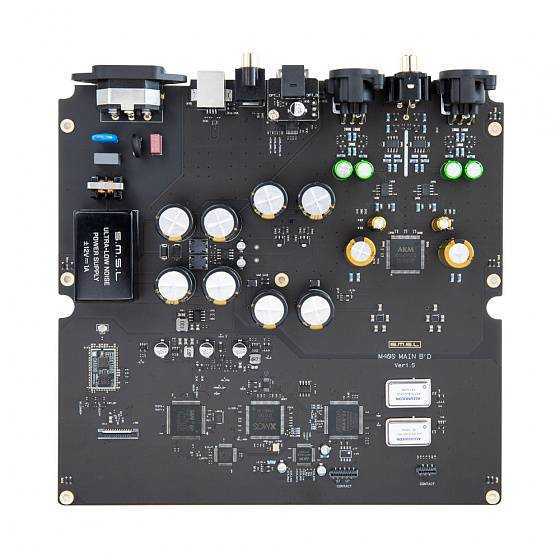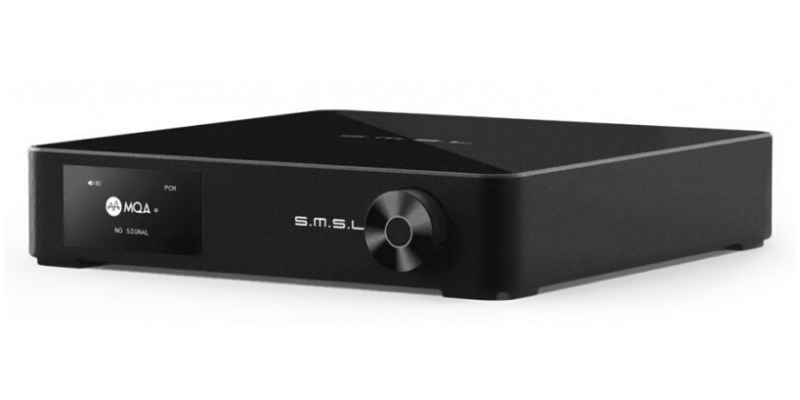Included remote control
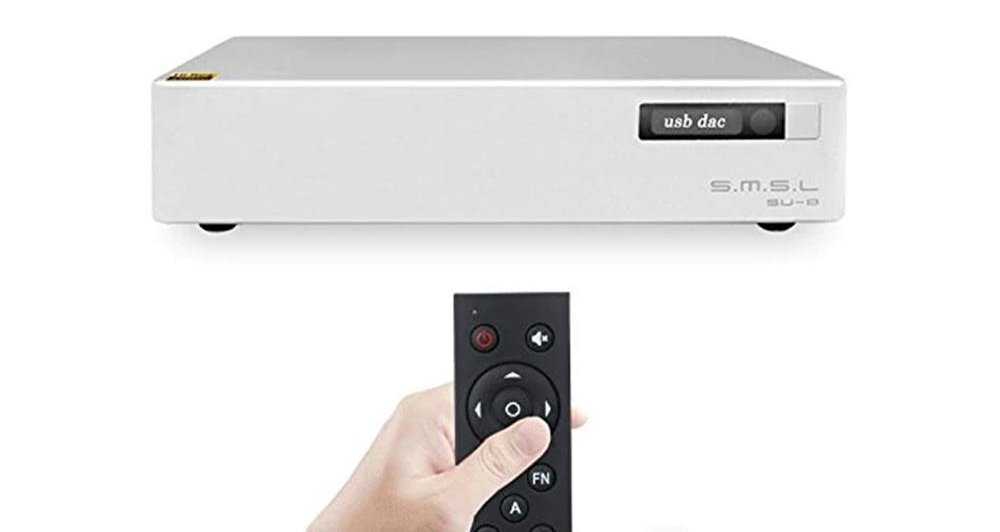
The SMSL SU 8 V2 DAC is delivered with its remote control. The latter requires two AAA batteries which are not supplied.
This remote control offers to control all the functions of the device: Power on / off, mute, volume control, input source selection, options relating to the DAC screen and parameters of filters and audio adjustment.
Note that a single remote control can control all DA-8 / SU-8 / DH-8 series devices from SMSL.
| Specifications | |
|---|---|
| Type | Balanced DAC |
| DAC Chip | 2x ES9038Q2M |
| USB interface | XMOS |
| Volume control | Oui |
| Inputs | USB-BOptiqueCoaxial |
| Outputs | RCA stéréo asymétrique XLR stéréo symétrique |
| Sampling rate | USB : 44.1-768kHz 32bit (PCM) / DSD512S/PDIF : 32-192kHz 24bit (PCM) DSD64 (DOP) |
| Dynamic range | 120dB |
| SNR | 116dB |
| THD+N | 0.0003% |
| Output level | RCA 2VrmsXLR 4Vrms |
| Power consumption | 3W |
| Idle consumption | 0.1W |
| Supported OS | Windows 7 / 8 / 8.1 / 10Mac OSX10.6 and aboveLinux |
| Dimensions | 185x40x125mm |
| Weight | 1kg |
Для начала спецификации:
 ЦАП имеет 3 входа
ЦАП имеет 3 входа
: USB, оптический и коаксиальный S/PDIF.
- по USB может принимать PCM до 32 бит и 768 кГц и DSD до DSD512 (22.5792 MHz)
- по оптике и коаксиалу PCM 24 бит 192 кГц
Выходы RCA
: напряжение при 0 dbFS 2.05 Vrms
Комплект поставки весьма «богатый» помимо самого цап и блока питания в коробочке обнаруживаем целых 3 кабеля:
- USB A B для подключения к компьютеру
- OTG кабель microUSB — USB B
- USB кабель с разъемом питания на другом конце (видимо если некуда воткнуть блок питания)
Последние 2 даже не распаковывал, так и лежат:
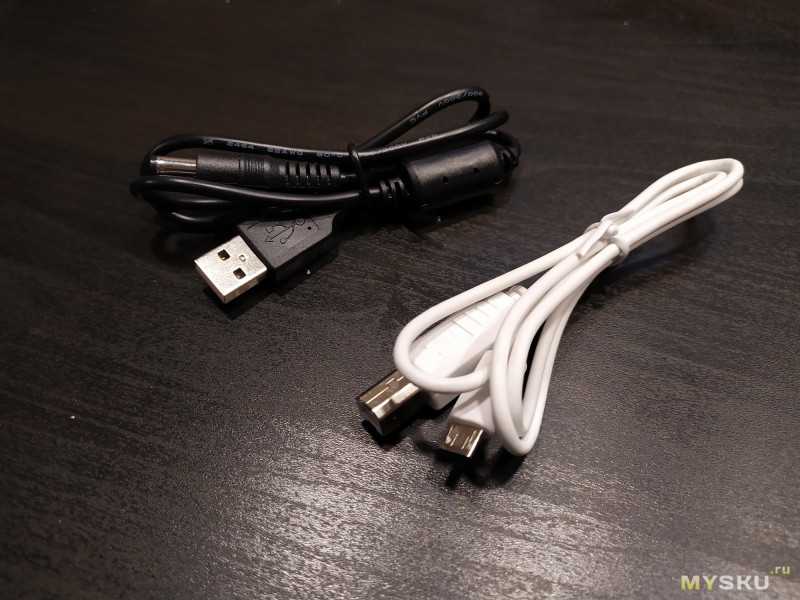
По просьбам трудящихся сделал фото внутренностей:

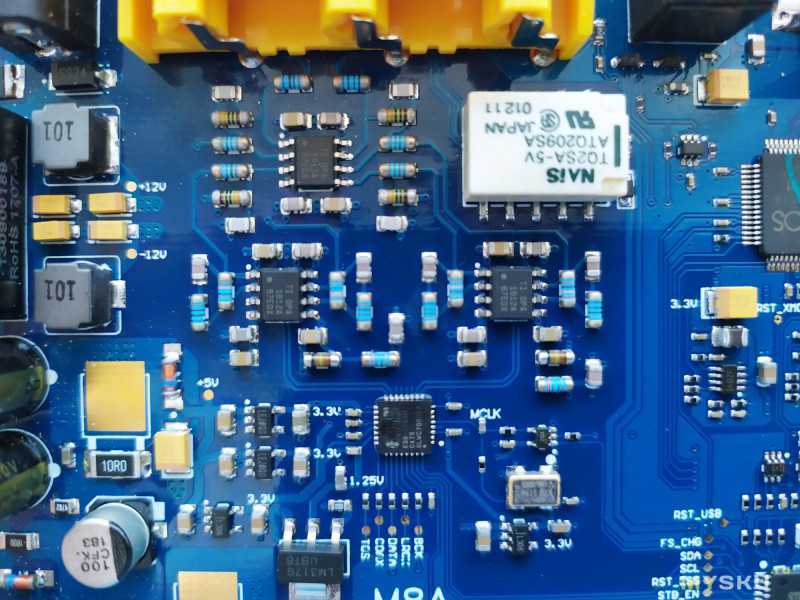
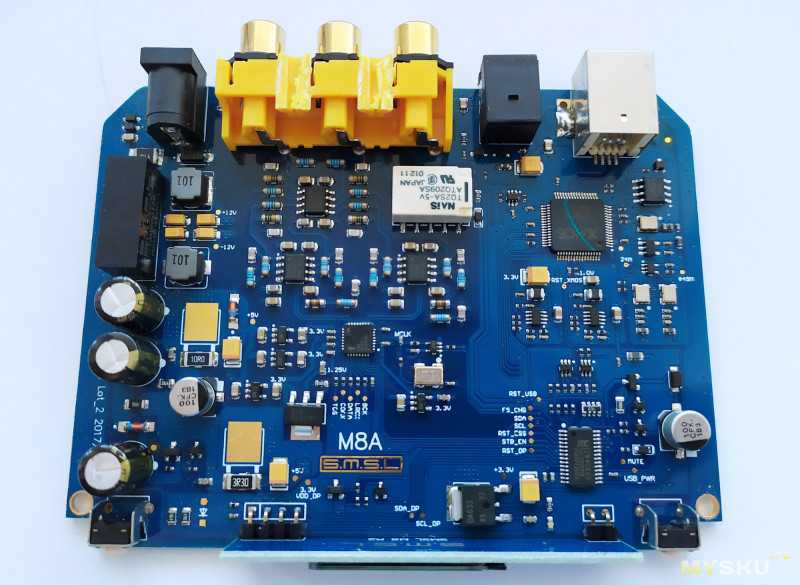
Я покупал свой экземпляр примерно за 14 т.р., не так давно моя версия продавалась за 10-11 т.р., а последняя за 12-13. Но, в связи с последними колебаниями курса уже цена не такая привлекательная(.
Никаких распаковок и дифирамбов китайской инженерной мысли не будет, а будет полное тестирование с использованием измерителя
AuduiPrecision APx586
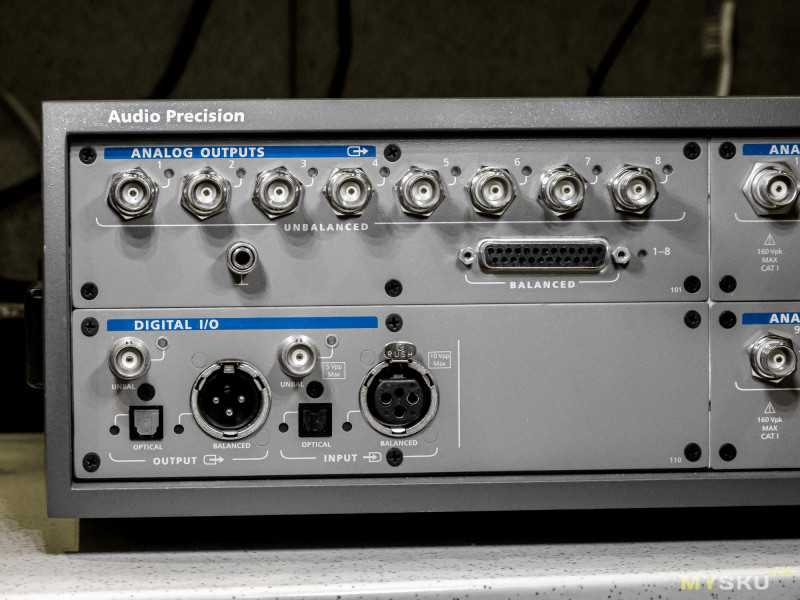
Домашний питомец SMSL A2
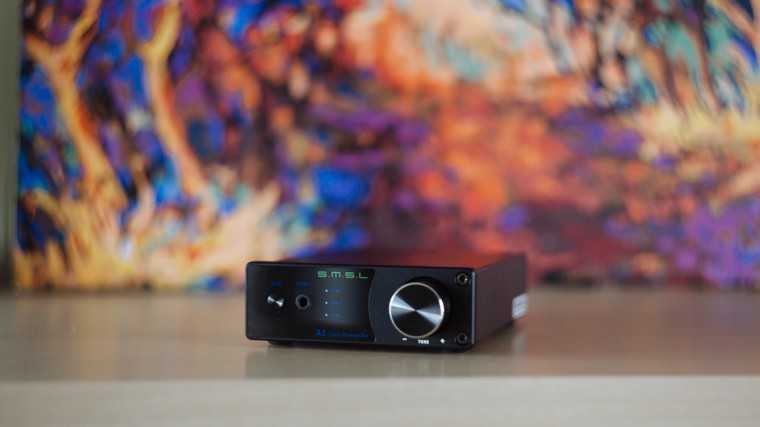
Третий предусилитель уже не ЦАП, а вполне серьезная, хоть и небольшая база для домашнего кинотеатра или акустической стереосистемы. SMSL A2 совсем не портативный и у него есть внушительный блок питания.
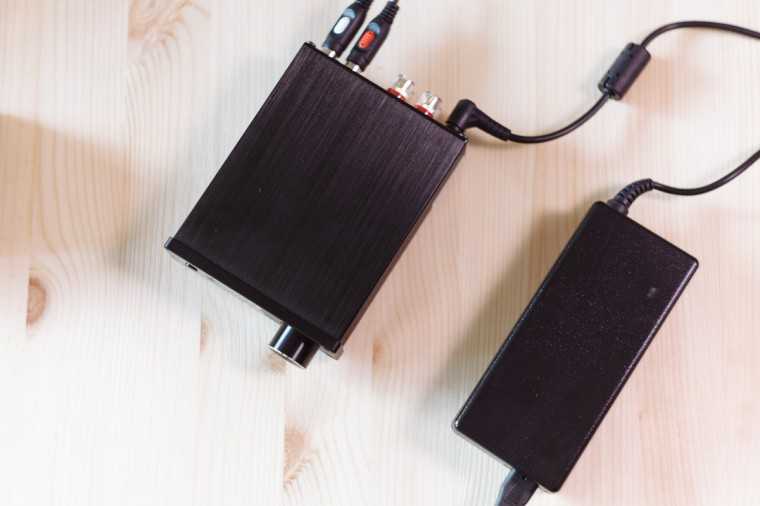
40 Вт на канал и выход для сабвуфера – начинающему киноману и аудиофилу достаточно. Только инструкцию обходить не рекомендую, здесь есть несколько нюансов по настройкам. Тут можно переключится между входами при помощи кнопки на передней панели устройства, присутствует встроенный эквалайзер, позволяющий регулировать низкие и высокие частоты.
- Выходная мощность: 2 x 40 Вт @ 4 Ом
- Соотношение сигнал/шум: >90 дБ
- Перекрестные помехи: < -90 дБ
- Диапазон частот: 20 — 20.000 Гц (± 3 дБ)
- Сопротивление колонок: 3 — 16 Ом
- КГИ+Н: <0,05 %
- Входы: 2 x RCA; 3,5 мм
По звуку этот предусилитель понравился больше. Хотя и полноразмерная акустика ве таки посерьезнее наушников. От классики, до фирменных завываний Тома Йорка и ремастеринговой версии сборника почему-то вспомнившегося Билли Айдола – все звучат хорошо.

А кинозвук – ещё лучше. Да, здесь только стерео и саб, но они заставили пересмотреть пару раз последнюю сцену под дождем из Bladerunner.
Synergy
Amp Pairings
For most of my listening on the SU-9, I used 2 amplifiers, the Schiit Magnius for the balanced tests, and my Aune X7s for testing the single-ended output of the DAC. Since both of these amplifiers have balanced capability, I listened using the balanced outputs for both headphone amplifiers.
The pairing of the SU-9 with the Magnius tends to be a bit thinner when compared to how it sounds through the slightly warmer Aune X7s. I ended up liking how the SU-9 sounds with the Magnius though, as SU-9 already manages to sound quite full even without the timbre coloration from the Aune x7s.
Also, the Magnius tended to be better at presenting the details that the SU-9 is capable of presenting.
Headphone Pairings
For headphones, I first listened to the SU-9 through my HD600 connected to the Magnius, and I liked how the combination worked. The HD600 tends to roll off quite a bit at the frequency extremes, and I think the SU-9 was able to help alleviate that a bit by giving the HD600 a bit more mid-bass dynamic impact.
The smooth and detailed midrange on the HD600 though was still there, so the SU-9 was able to compensate a bit for the shortcomings of the HD600 while being able to retain its more desirable attributes.
I then tried the same system with my Hifiman Ananda, and the combination was also quite good. I found that the dynamic impact is emphasized on the Ananda, and this made the Ananda sound a bit more natural in its presentation.
I love the width and transparency of the Ananda, and I think the things that I love about the Ananda’s soundstage were retained with the help of the detailed presentation of the SU-9.
MQA
I’ve had many MQA devices before, and I haven’t found much of a benefit to having the ability to decode MQA on a DAC. I’ve had it with ifi DACs and my Audioquest Dragonfly Red, but I mostly dismissed it as being something nice to have, but not a feature that would spell much of a difference to me.
With the SU-9, I tested the MQA feature that’s available on the SU-9 by playing certain tracks on Tidal that had both a CD-quality version, as well as an MQA version. I was surprised that the difference between the MQA version and the CD-quality version was apparent.
I found that the MQA had a bit more depth to it, and details became more apparent. I think the SU-9’s pre-amp and DAC stage can render details with that much more accuracy that nuances in the track quality become immediately apparent.
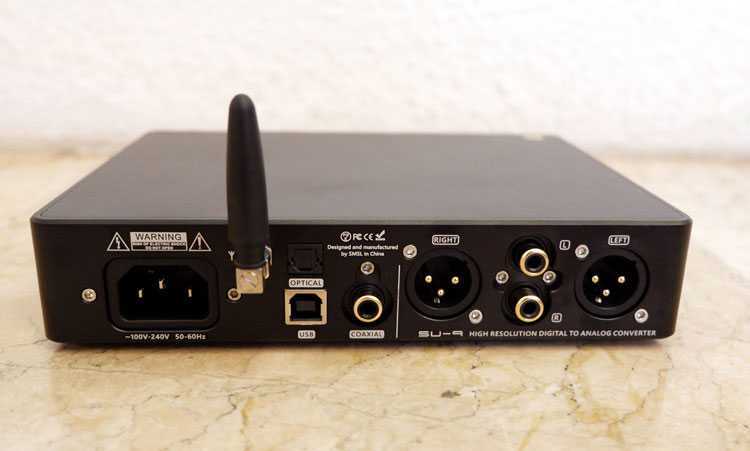
Aune X8 Magic DAC
$299
Technical
The Aune X8 Magic DAC is Aune’s entry-level stand-alone DAC priced at $299, which was released earlier this year. According to the Aune website, it utilizes an FPGA(field-programmable gate array) which is programmed in-house, instead of using an off the shelf DAC chip. This would take considerably more engineering on the part of Aune, as compared to using an off the shelf DAC chip from manufacturers such as ESS or AKM.
In terms of weight and size, I think the 2 DACs are comparable. Inputs on both devices are practically the same, except that the SU-9 has Bluetooth input. For the outputs, the SU-9 has both single-ended and balanced XLR outputs, compared to just the single-ended outputs on the X8. Physically, the most glaring difference between the 2 DACs is the presence of a full-color display on the SU-9, compared to the LED lights that indicate the input selection and PCM filters on the X8.
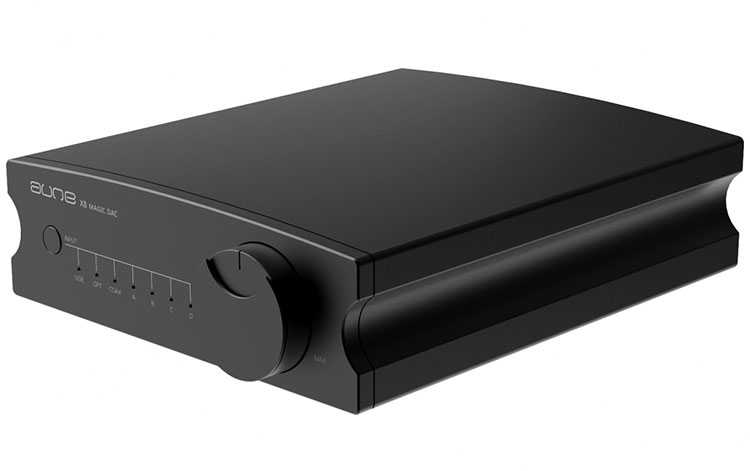
Tuning
Since the X8 only has single-ended outputs, I decided to just use the single-ended output on the SU-9 for the comparison. The first difference between the 2 is that the line-level outputs of the 2 devices aren’t volume matched again, so I had to volume match the 2 DACs again. I know it won’t be perfect, but I tried to match the volume levels as best I can.
Once the volumes on the 2 devices are matched, I can hear that the SU-9 sounds slightly thicker when compared to the X8. Especially in the bass region, where the SU-9’s drum beats sound more substantial, compared to the X8’s slightly thinner bass region. The vocal range details are about the same on both, as they are able to present the clear and textured vocals. However, the treble region on the X8 seems to be just a bit sparklier and more detailed.
The soundstage might be slightly more airy on the X8 when both DACs are being run on single-ended, but when the SU-9 is run on balanced mode, the SU-9 seems to be able to breathe a bit more air into the soundstage. Image placement on both DACs seems to be about the same, as they are both able to create a clear center image and place instruments in the right places.
Overall, I can say that on single-ended, both DACs are toe to toe. But with SU-9’s balanced outputs, I think the SU-9 just edges out the X8 a bit in the soundstage department.
Sound Impressions
The first thing that I noticed on the SU-9 is the overall smoothness of the presentation of the sound in the entire frequency spectrum. It doesn’t sound glossed over, the overall sound character is smooth, without much of an edge, but remains impactful. I would have wanted to hear a bit of an edgier character though, maybe just a bit of a stronger bite at the end of each beat.
Impact
The lower frequencies on SU-9 are well articulated, full-bodied, and smooth. Listening to drum beats from songs such as Boston by Augustana, the SU-9 makes the bass drum beats very full, but I would have wanted to hear a bit more nuance and texture with each beat.
Vocal Performances
The vocal range on the SU-9 is quite pleasant and nuanced, the vocal track of Gotta Be Patient by Michael Buble sounded very natural. Male vocals were well articulated and very textured. I like how each word is properly pronounced because of how well the vocals are rendered by the SU-9.
Headroom
With the smoother character found on the SU-9, one would tend to expect that the treble region on the SU-9 might end up being glossed over because of the smoother presentation. However, the treble presentation on the SU-9 is still presented well, there are treble details that can clearly be heard.
Instrument separation is also rendered quite well through the SU-9, and when listening to orchestral tracks like the orchestral version of U2’s Beautiful Day played by the Royal Philharmonic. Each of the violins are distinct from the other violins, cellos, or basses. I’m quite impressed with how well each instrument is distinctly presented on their own.
Staging
The soundstage is presented with quite a bit of width on the SU-9, the soundstage that is formed in front is also quite respectable. The width of the stage is nicely wide as well, which then creates enough space to accurately render sound images within the sound stage.
Each falling ball on the song Bubbles by Yosi Horikawa seems to fall in a distinct place around my head when being heard through the SU-9. This gives me the impression that the SU-9 can accurately place sound elements within a certain soundstage.
The overall sound of the SU-9 is quite smooth, but it doesn’t automatically equate to being glossed over. It has a dynamic bass region and a smooth but detailed top end.

How long is the warranty period?
an data-preserver-spaces=»true»>HiFiGo warrants to the original purchaser that the Product(s) shall be free of any defect in material or workmanship for a period of one year for labor and one year for parts from the date of the original order except the items listed below:
Desktop DAC/AMPs : 2 years warranty
IEMs and dongles: 1 year warranty
Accessories: 3-6 months warranty according to brands policy
Should the Product(s) supplied by HiFiGo prove defective because of improper workmanship or material as reasonably determined by us, HiFiGo agrees, at its option, to either repair or replace the Product free of charge, excluding any shipping or handling charges.
This warranty extends only to personal use & does not extend to any product that has been used for commercial use, rental use, or use which is not intended. There are no warranties other than expressly set forth herein.
THE WARRANTY DOES NOT APPLY TO THE FOLLOWING
- Damage due to user negligence, accidents, dis-assembly, waterlog, misuse, abuse, alterations or vandalism.
- Improper or inadequate maintenance.
- Failure to perform required preventive maintenance
- use not following the ‘User Guide’ or any additional safety, use, or warnings included in the product materials.
- Unauthorized modification or commercial use.
- Damage in return transit.
- Unsupervised use by children under 18 years of age.
- Accidents, abuse, misuse, improper installation, problems with electrical power, acts of third parties.
- Products that are altered or repaired by anyone not authorized by HiFiGo
- usage not following instructions accompanying the Product(s)
- failure to perform required preventive maintenance,
- weather conditions, lightning, fire, water, or any acts of nature
- Furthermore, HiFiGo is not liable for incidental or consequential damages of any nature resulting from the use of this product and any liability shall not exceed the purchase price of the product.
Disclaimer of Warranties — Except as set forth herein, HiFiGo disclaims any and all warranties and representations other than those explicitly specified in this contract; any warranties, if separately provided in writing, are extended only to the Buyer whose name is shown on this invoice/contract. Warranties do not cover product damaged by external causes, including accident, abuse, misuse, improper installation, problems with electrical power, acts of third parties, Products that are altered or repaired by anyone not authorized by HiFiGo, usage not following instructions accompanying the Product(s), or failure to perform required preventive maintenance, including but not limited to backups, problems caused by use of software, parts and components not supplied by HiFiGo, weather conditions, lightning, fire, water, or any acts of nature; HiFiGo shall not be obligated to provide any warranty service or obligations unless customer has paid its invoices in full under this or any other HiFiGo invoice. HiFiGo shall have the sole discretion in determining whether the Product is covered under the warranty for labor and/or warranty for parts
Governing Law — This contract shall be governed and construed per the laws of the People’s Republic of China. Buyer agrees that competent courts in the People’s Republic of China shall have the exclusive jurisdiction over any legal action concerning this contract. In the event of any dispute related to this contract, the prevailing party shall be entitled to reasonable attorneys’ fee and costs.
Internals
As I’m sure you’ve picked up, the SU-9 is a technological marvel. It boasts the flagship, 8-channel, ES9038Pro chip, and associated ES9311 voltage regulators. The output stage is based on Texas Instruments Burr-Brown OPA1612 dual op-amps (one for single-ended RCA and two for balanced XLR).
The SU-9’s internal circuitry.
Like the SMSL SP200 amplifier, the internal ultra-low noise power supply is located within the case, rather than utilizing a wall-wart type power adapter.
The SU-9’s power supply.
Bluetooth
The SU-9 supports all the standard Bluetooth codecs, including AAC, SBC, aptX, aptX-HD, and LDAC. Of note, it also supports the new Ultra Audio Transmission (UAT) codec designed by the HiBy company. UAT uses HiBy’s proprietary algorithms to work around data transfer limitations to support higher resolution audio. Initially only available on HiBy DAP products, UAT appears on other devices like the Hidizs AP80 Pro and Cayin N8.
Any improvement to Bluetooth fidelity is welcome, so it’s great to see UAT included in the SU-9.
| Bluetooth Codec | Bit Depth (bit) / Sample Rate (kHz) | Supported Bit Rate (kbps) |
|---|---|---|
| UAT | 24/192 | 1200/900/600 |
| LDAC | 24/96 | 990/660/330 |
| aptX-HD | 24/48 | 576 |
| aptX | 16/44.1 | 352 |
| SBC | 16/44.1 | 328 |
| AAC | 16/44.1 | 320 |
Closeup of the XMOS USB chipset.
Sound

Pure amplifiers in general should have sufficient transparency and neutrality. Their task is to amplify the signal, not to add and change it in any taste feed. But this is, of course, on paper and measurements. In fact, the situation is somewhat different, although the amplifier from SMSL is quite close to the ideal. It is almost transparent and its impact on the record is quite modest. And yet, it is there. Thus, it turns out that the device should be described just in the plane of the signal difference before and after amplification.
Low Frequency carry the most differences. They are enough to accurately maintain depth and speed, but they literally add a little massiveness and corporeality. The sound gains a little more confidence and emotionality. The recording begins to sound a little more warm and enthusiastic. In our opinion, low frequencies are a strong point of the SH-9. Here they are very elastic and full-bodied, almost in any records the bass is always in its place, never interrupting the middle range. They always sound very accurate and clear.
The midrange does not differ much. SMSL SH-9 keeps the recording as it is. At the same time, it adds a little warmth and weight on the one hand, but perfectly emphasizes the transfer of nuances of sound, timbres and emotions on the other.
High Frequency is practically no different. Just as detailed, transparent and expressive, without smoothing or simplifying. Without sagging dynamic range, but just as fast, detailed and long where it should be.
The scene is also fully inherited from the source. The amplifier does not change its structure, only slightly increasing its width and depth. Thanks to this, the positioning of instruments, the separation of plans and the transmission of the overall sound picture are slightly improved.
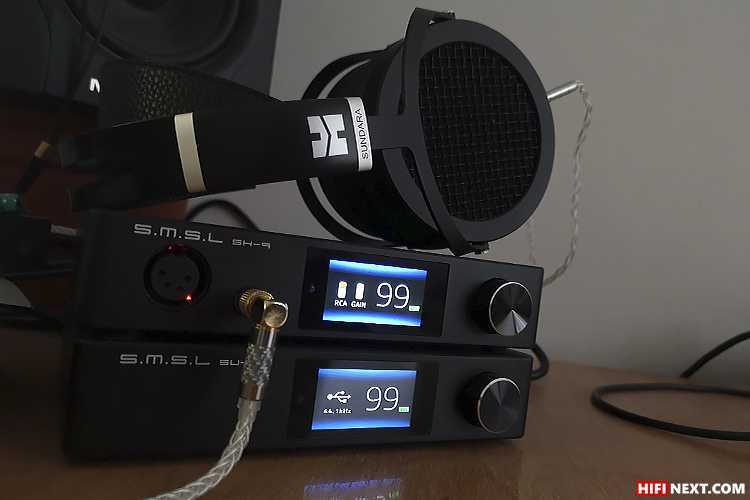
Note that we tested the SH-9 with its sibling, the new SMSL SU-9 DAC, which perfectly combines aesthetically complementing the stack with its repeating design and sound delivery.
Звук
Для прослушивания плеера использовались преимущественно следующие наушники:
- HiFiMan Re600
- Philips Fidelio X1
- Dunu DN-2000
- Lear LUF-4F
- Rhapsodio RTi1
В роли источника выступал MacBook Pro Retina Late 2013.
Еще раз хочу подчеркнуть: очень жаль, что SMSL использовали в роли усилителя чип MAX. Предназначенный для самых недорогих и критичных к энергопотреблению устройств, в M2 он явно недотягивает до уровня остальных элементов. Поэтому звук получается немного сглаженным, с небольшим акцентом на НЧ и отчасти странным поведением ВЧ.
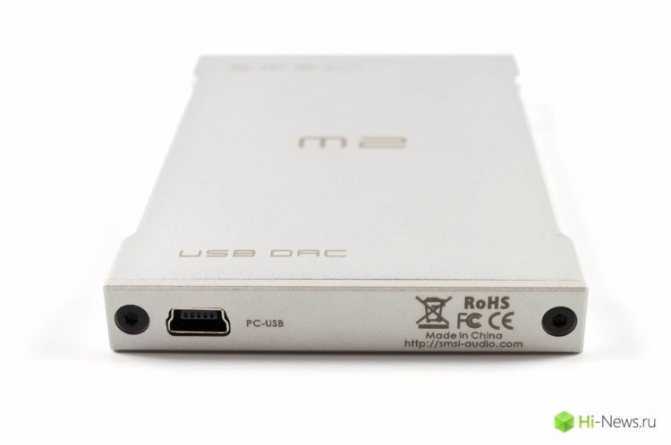
Бас в целом неплохой для данной ценовой категории. Он, конечно, уступает более дорогим решениям, но для 65 долларов он хорош как по глубине, так и по уровню проработки. Небольшое выделение этого диапазона в целом идет на пользу общему восприятию звука устройства, прибавляет подаче телесности и основательности.
Средние частоты нареканий особых не вызывают. Нормальная детализация, проработка воображаемой сцены и передача эмоций — вполне на уровне конкурирующих решений.
Высокие частоты — самый спорный момент. Усилитель просто не может на 100% отрабатывать их по разрешению, и из-за этого они приобретают синтетический оттенок, но, правда, заметно это в основном на дорогих наушниках. Количественно ВЧ на мой вкус — вполне достаточно.
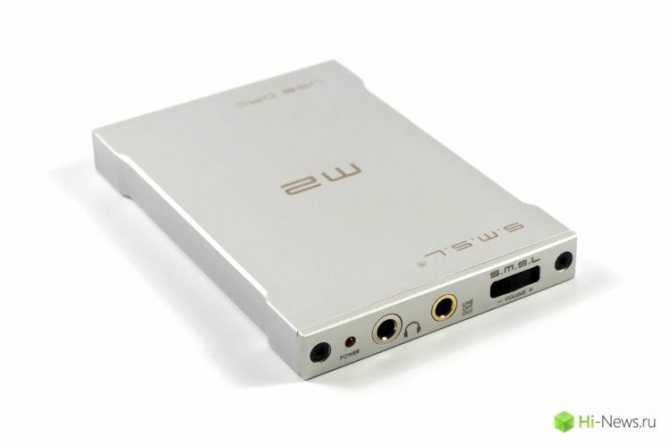
Ситуация заметно меняется, если подключить M2 через линейный выход и какой-то хороший внешний усилитель. Звук выравнивается, становится более детальным, с нормальной проработкой ВЧ и быстрой отработкой атак, хорошо подходящей для большинства наушников долларов до 200.
Естественно, если сделать поправку на цену — недостатки звука M2 не являются столь уж критичными, ведь устройства, не имеющие особо выраженных недочетов, стоят в несколько раз дороже.
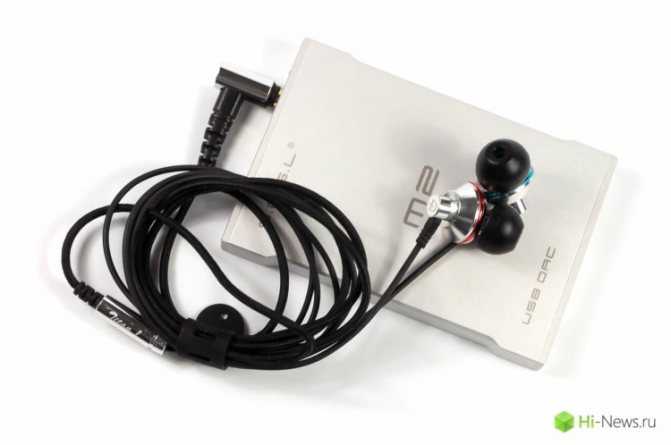
SMSL M100 MK2
Technical
It might be unfair to compare the SU-9 to a product that’s just ¼ the price, but since they’re coming from the same company, and the DAC chipset inside both devices are from ESS, I gave it a shot.
Of course, form-factor wise, the SU-9 has quite a bit more heft, and the M100 MK2 is simply a more compact and lighter unit. There will be quite a few added features available on the SU-9 such as Bluetooth connectivity, a better screen, filters, and timbre control, but I’m more interested in how much their sound would differ.
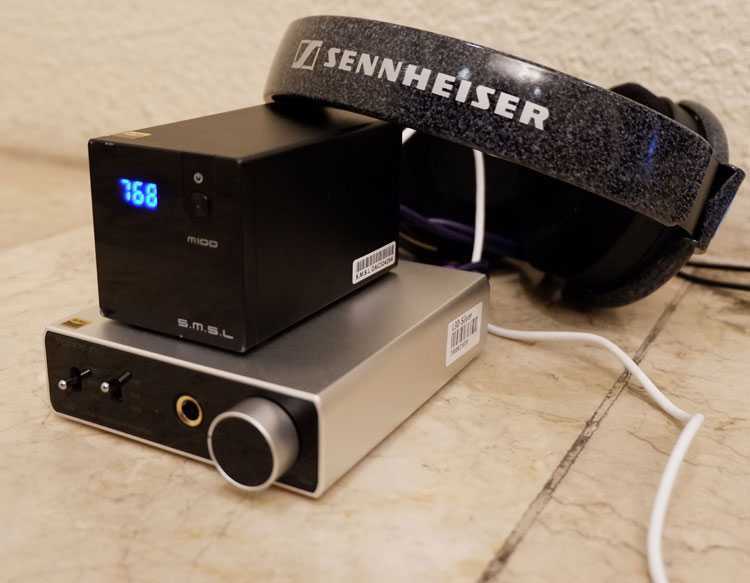
Tuning
One of the first things that I loved about the M100 Mk2 is the dynamic impact that it has over most of its competition. This is the same dynamic impact that the SU-9 can produce, albeit at a much more refined level. Where the M100 would come short in detail retrieval especially in the treble region, the SU-9 can deliver on the shortcomings of the M100 MK2.
The soundstage is where the SU-9 is set apart from its little brother. Although the M100 MK2 has a respectable amount of soundstage and has fairly accurate imaging, the SU-9 has a much wider center image where each sound element can be placed accurately.
Overall, the SU-9 is simply a much more refined product, where each of the positive attributes of SMSL’s M100 MK2 has simply been improved upon by their SU-9.
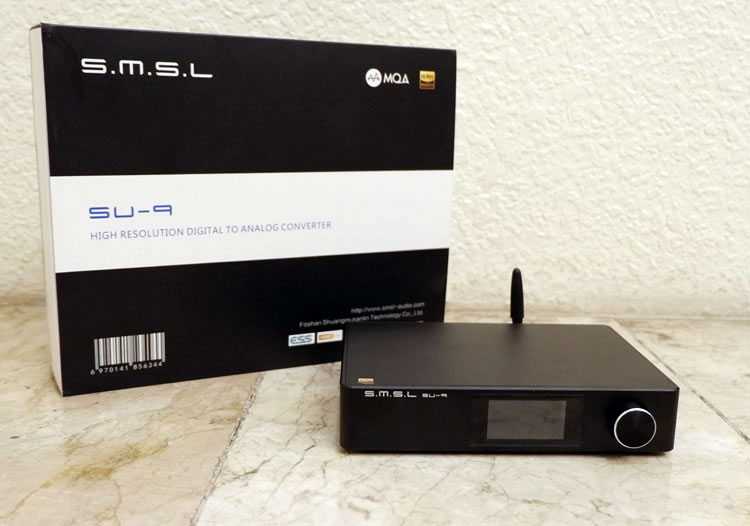
Technology Inside
DAC
SMSL has opted to use a single TOTL ES9038PRO DAC chipset version for the SU-9. The ES9038PRO is designed with 8 internal DAC channels compared to the 2 that are available in the Q2M mobile versions. This allows the manufacturer to design a true balanced DAC around the ES9038PRO chipset.
Combined with a 2nd gen XMOS USB stage the SU-9 is capable of decoding numerous lossless formats that include MQA, PCM streams up to 32bit, 768Khz, and native DSD decoding up to DSD512 and supports full MQA rendering and decoding. DoP64 is supported via optical and coaxial.
Power
Of course, having a good DAC chip will not automatically translate into a good performance without having great components surrounding that DAC chip.
To ensure low noise coming in from the power supply, SMSL decided to use an ES9311 regulator which is a +3.3V low-noise, low-dropout regulator, designed specifically for DACs eliminating the need for output decoupling capacitors. The result of this should be an ability to produce very clean power, with noise levels being kept as low as 1μV.
Clocking
Aside from the power supply, the SU-9 was also designed with Ultra-low phase noise and optimized clock processing circuits to achieve ultra-low clock jitter. This will give the SU-9 an ability to recreate more evenly spaced samples, that will ultimately contribute to a more accurate recreated signal.
Bluetooth
Streaming options on DACs are starting to become the norm with Topping and Burson among the big names offering Bluetooth decoding capability.
The SU-9 is no different but apart from offering all the latest Bluetooth Codecs including LDAC, AptX, AptXHD, AAC, SBC, it also interestingly includes an even higher codec, UAT. UAT is actually proprietary to HiBy previously with their W5 dongle and DAPs via their HiBy Music app so good to see it now being more widely adopted by desktop manufacturers.
This codec capable of an excellent 24bit/192kHz lossless level but it does require the ability of the source to transmit UAT stably which might still be a little niche. DAPs such as the HiBy R6 Pro and HiBy R8 can do that.
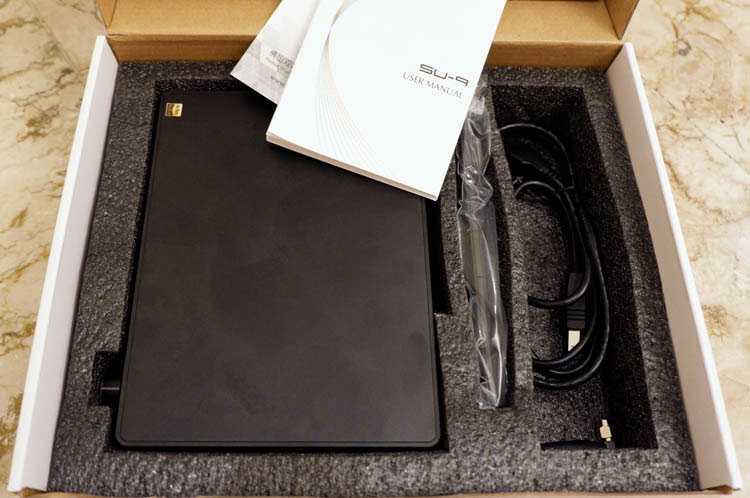
Technical Specifications
- Form: DAC
- Digital inputs: USB/Optical/Coaxial/Bluetooth
- Analog outputs: RCA/XLR
- THD+N: 0.00009%(-121dB)
- Dynamic range: XLR 130dB, RCA 123dB
- SNR:130dB
- Output impedance: XLR 207Ohms, RCA 142Ohms
- Bit depth: USB 1bit,16-32bit, Optical/Coaxial 1bit,16-24bit
- USB sampling rate: USB PCM 44.1-768kHz, DSD 2.8224-22.5792MHZ,
- Optical/Coaxial sampling rate: PCM 44.1-192kHZ, DSD dsd64(DoP)
- Bluetooth sampling rate: UAT: 24bit/192kHz (1200kbps/900kbps/600kbps), LDAC: 24bit/96kHz (990kbps/660kbps/330kbps), aptX-HD: 24bit/48 kHz-576kbps, aptX: 16bit/44.1 kHz-352kbps, SBC: 16bit/44.1 kHz-328kbps, AAC: 16bit/44.1 kHz-320kbps
- Power Consumption: 5W, <0.5W (standby)
- Size: 187.5X154X40mm (WxHxD)
- Weight: 800grams
The box displays surprisingly few technical specifications.



























